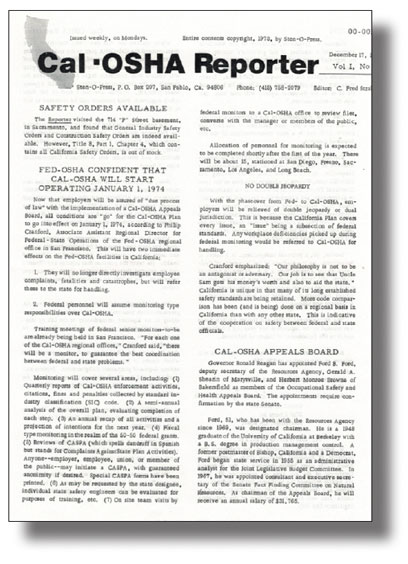In 1973, inflation was at more than 6%, the U.S. Supreme Court made a landmark ruling on reproductive rights, and OPEC voted to increase the price of oil by 200%. As the saying goes, history doesn’t repeat, but it echoes. Fifty years later, those same issues are front and center in the American consciousness, not to mention controversial presidents and conflicts in far-off lands.
 And with 1973 about to become 1974, a new publication debuted on December 17th – Cal-OSHA Reporter. It preceded the advent of the state’s Cal/OSHA program by two weeks. We are no longer printed via offset press in San Pablo by Sten-O-Press on Mondays. In 1994, Dale Debber and providence Publications bought COR, pledging it would remain the safety community’s publication. Now, it is mandatory Friday morning reading for most of California’s occupational safety and health community.
And with 1973 about to become 1974, a new publication debuted on December 17th – Cal-OSHA Reporter. It preceded the advent of the state’s Cal/OSHA program by two weeks. We are no longer printed via offset press in San Pablo by Sten-O-Press on Mondays. In 1994, Dale Debber and providence Publications bought COR, pledging it would remain the safety community’s publication. Now, it is mandatory Friday morning reading for most of California’s occupational safety and health community.
Twenty-five years ago, Anne Bell retired, and Kevin Thompson, after a transition with Bell, took over as editor.
Cal-OSHA Reporter began like many California start-ups – in a garage. Fred Strahm, a veteran of the workers’ compensation world, saw the need for information about the new Cal/OSHA program signed into law by then-Governor Ronald Reagan and enabled by the federal Occupational Safety and Health Act in 1970.
The agency started on January 1st, 1974. In our first issue, Strahm wrote: “Now that employers will be assured of ‘due process of law’ with the implementation of a Cal-OSHA Appeals Board, all conditions are ‘go’ for the Cal-OSHA Plan to go into effect.”
The first three members of the Appeals Board were Ford B. Ford, Gerald A. Shearin, and Herbert Monroe Browne. The first Standards Board, which supplanted the Industrial Safety Board, included Albert W. Turner, Gerald O’Hara, Patrick Clancy, Leo R. Westwater, Dr. Harold V. Brown, J. Earl Coke, and William K. Stuckey.
At the time, what is now known as the Division of Occupational Safety and Health was known as the Division of Industrial Safety; its chief was Richard Wilkins. The change to DOSH came later.
Notice a sameness? In those days, all the top Cal/OSHA positions were filled by men. Since then, DOSH has had two female chiefs and several female members of the Appeals Board, and today’s Standards Board is majority female – five of seven members.
A lot of water has passed under the figurative bridge between 1973 and 2022. Cal-OSHA Reporter has been there all the way to ford the shoals along the safety journey.
Shoals, indeed. In 1984, Publisher Strahm passed away, his wife Lois became publisher, and Bell became editor. In 1987, Governor George Deukmejian defunded Cal/OSHA, turning private-sector enforcement over to Fed-OSHA on July 1st, and the agency retained jurisdiction over public workplaces.
Bell wrote that the momentous decision “will have no effect on publication of the Cal-OSHA Reporter. We know our readers are professionals with workplace safety and health responsibilities. Those of you with jobs in the public sector need to know what the Division of Safety and Health (DOSH) plans to do. Those of you in the private sector need to know how Fed-OSHA will affect your work in California.”
Cal-OSHA Reporter then became California OSHA Reporter on August 3rd, 1987. But in the fall of 1988, voters approved Prop. 97, restoring Cal/OSHA’s funding. In the first issue of 1989, Cal-OSHA Reporter’s original name was restored.
Another significant milestone along the way included the creation of the Injury and Illness Prevention Program in the early 1990s, a feat the Fed-OSHA has yet to accomplish. In the late 1990s, the agency had protracted efforts to revise the bloodborne pathogens standard to protect healthcare employees from needle sticks during the AIDS epidemic and establish an ergonomics standard. The latter attempt concluded when a court turned back challenges to the controversial compromise regulation, General Industry Safety Orders §5110.
The Tosco Avon Refinery flash fire and explosion led to reforms in process safety management. It spurred the passage of AB 1127, an omnibus safety bill that increased potential Cal/OSHA penalties and made it possible to prosecute managers in the most serious cases.
Cal/OSHA and stakeholders started work on a heat illness regulation in the early 2000s, but that effort stalled until a series of outdoor employee deaths, marked by the heat fatality of a pregnant teenage agricultural laborer, led to the passage of the first heat illness prevention standard in the country.
Concern over airborne infectious diseases led to the adoption in the late 2000s of the aerosol transmissible diseases standard for healthcare. More than a decade later, with COVID and an emergency standard receding, DOSH and the Standards Board will begin work on a permanent ATD standard for general industry. While that effort is ongoing for the next two years, a “non-emergency,” slimmed-down version of the COVID ETS will take effect.
There is far more history that cannot be captured in a short retrospective, including the internet’s coming of age, our website, and its searchable content. Fifty years in the grand scheme of things is not long, but publishing the history is a significant milestone. We here at Cal-OSHA Reporter are proud to have served the occupational safety and health community in the print era and now the electronic age. Who knows what events we will cover in the future and what innovations in publishing will come along?
Whatever the future, Cal-OSHA Reporter plans to be there chronicling the next 50 years – and beyond. And our pledge to the safety community continues: We remain focused on serving the community.

